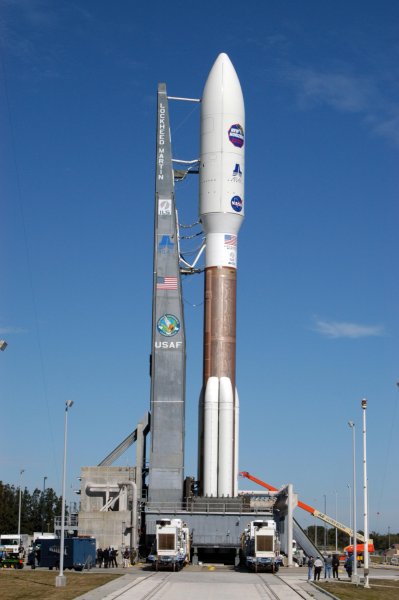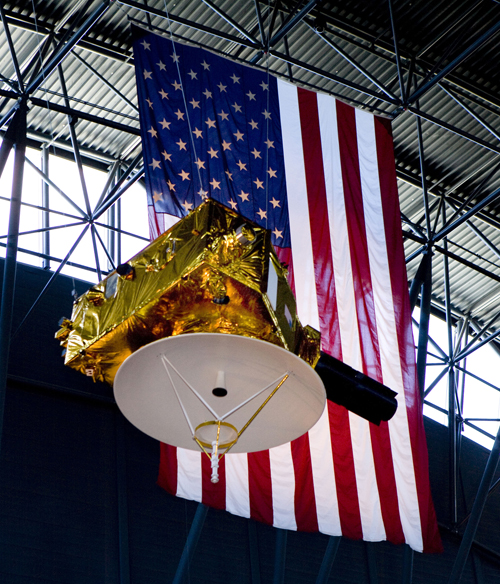NASA's Mission to Pluto and Beyond
On January
19, 2006 NASA launched the first spacecraft intended to visit Pluto and the
Kuiper belt. The Kuiper belt contains a
huge number of icy planetismals, far outnumbering all the planets in our solar
system, yet we know very little about this region. The New Horizons mission aims to fill in this
gap in the knowledge of our solar system.
The Kuiper belt is the largest source of cometary impactors on Earth,
and in fact contains the remains of the materials that formed the planets of
our solar system. Scientists have
stressed the exploration of this region of our solar system as a top priority
as it will give them insight into many exciting areas of astronomy including
the formation of our solar system, the behavior of binary planet systems (and
other binary systems), the evolution of Earth’s atmosphere, and even the formation
and collection of the elements necessary to support organic life. With the completion of the New Horizons
mission to the Kuiper belt, we will have completed the exploration of our solar
system with unmanned probes. Scientists
of all kinds are excited about the new data this mission will produce to
confirm or improve our assumptions about the origin and characteristics of the solar
system Earth resides in.

The New Horizons Rocket, just before launch.
Information on the Spacecraft
What is the New Horizons
Spacecraft?
The New Horizons Mission is a 650
million dollar project that will go to the
“double planet”, Pluto and Charon to discover what lies at our Solar System’s
edge. This is the last planet to be visited by a spacecraft. It will also go on
to explore one or more objects in the Kuiper Belt beyond Neptune. The spacecraft’s
mass is 478 kilograms in total and is 0.7 by 2.1 by 2.7 meters in size. The
spacecraft is projected to arrive at Pluto in July or August of 2015. 5 months
prior to arriving at Pluto, the craft will start taking observations. They will
start taking daily studies 4 weeks before arriving at Pluto/Charon. After it’s
encounter, the craft will continue to taking observations for 4 months. The
data will continue to be sent 9 months after the encounter.
What are the scientific instruments on the craft?
There is a
high-gain antenna that is 2.1 meters in diameter. It also has a data rate of 38
kilobits per second at Jupiter and 0.6 to 1.2 kilobits per second at Pluto.
However, the Pluto encounter data will actually take a total of 9 months to
transmit. Alice is the ultraviolet spectrometer used for measuring gas
composition. Ralph combines an infrared spectrometer (LEISA) for mapping
surface composition with a color optical imager (MVIC) for mapping surface
structure and composition. REX is a radio experiment for measuring atmospheric
composition and temperature. LORRI is an optical telescope that provides the
highest resolution imaging of the surface. PEPSSI is a plasma-sensing
instrument for measuring the properties of the solar wind at Pluto, Pluto’s
atmospheric escape rate, and for searching for a magnetosphere around Pluto.
SDC is an instrument used to measure dust impacts at the New Horizons
spacecraft during its entire trajectory and was built by students at the
University of Colorado.
What are the power systems on the craft?
Power comes
from one radioisotope thermoelectric generator (RTG) that has 11 kilograms of
plutonium dioxide. The RTG will provide 240 watts of energy at 30 volts at the
beginning of the mission. But because of the decay of the plutonium, the power
will decrease to about 3.5 watts per year. By the time July 2015 comes, which
is the earliest the craft will arrive, it will only producing 200 watts. The
science instruments together need less than 28 watts of power.

A life-size model of the New Horizons spacecraft – provided by the Johns Hopkins University Applied Physics Laboratory, where the real New Horizons was designed and built – is on display at the Smithsonian National Air and Space Museum’s Steven F. Udvar-Hazy Center near Washington Dulles International Airport in Northern Virginia. The New Horizons display is at the far end of the James McDonnell Space Hangar, behind the space shuttle Enterprise. Credit: Johns Hopkins University Applied Physics Laboratory
When, where, and by whom was the craft built?
The New
Horizons Project Manger is Glen Fountain. Team leaders include Southwest
Research Institute and John Hopkins University Applied Physics Laboratory.
Other major partners involved are Ball Aerospace (Ralph instrument), Boeing
(STAR 48B upper stage rocket engine), Department of Energy (Power supply),
KinetX, Inc. (Navigation team), Lockheed-Martin (Atlas V launch vehicle), NASA
Goddard Space Flight Center (LEISA infrared focal plane), NASA Kennedy Space
Flight Center (NASA Launch Services Program), NASA Jet Propulsion Laboratory
(Technical Analysis), Stanford University (REX radio science investigation),
University of Colorado (Student Dust Counter instrument and Co-I support), and
Subaru Telescope (Kuiper Belt object search support)
How, when, and where was the craft launched?
The craft was launched January 19, 2006 at Cape Canaveral Air Force Station in Florida. The Atlas V 551 will be the first stage of the rocket. The second stage is the Centaur. The STAR 48B solid rocket is the third stage.